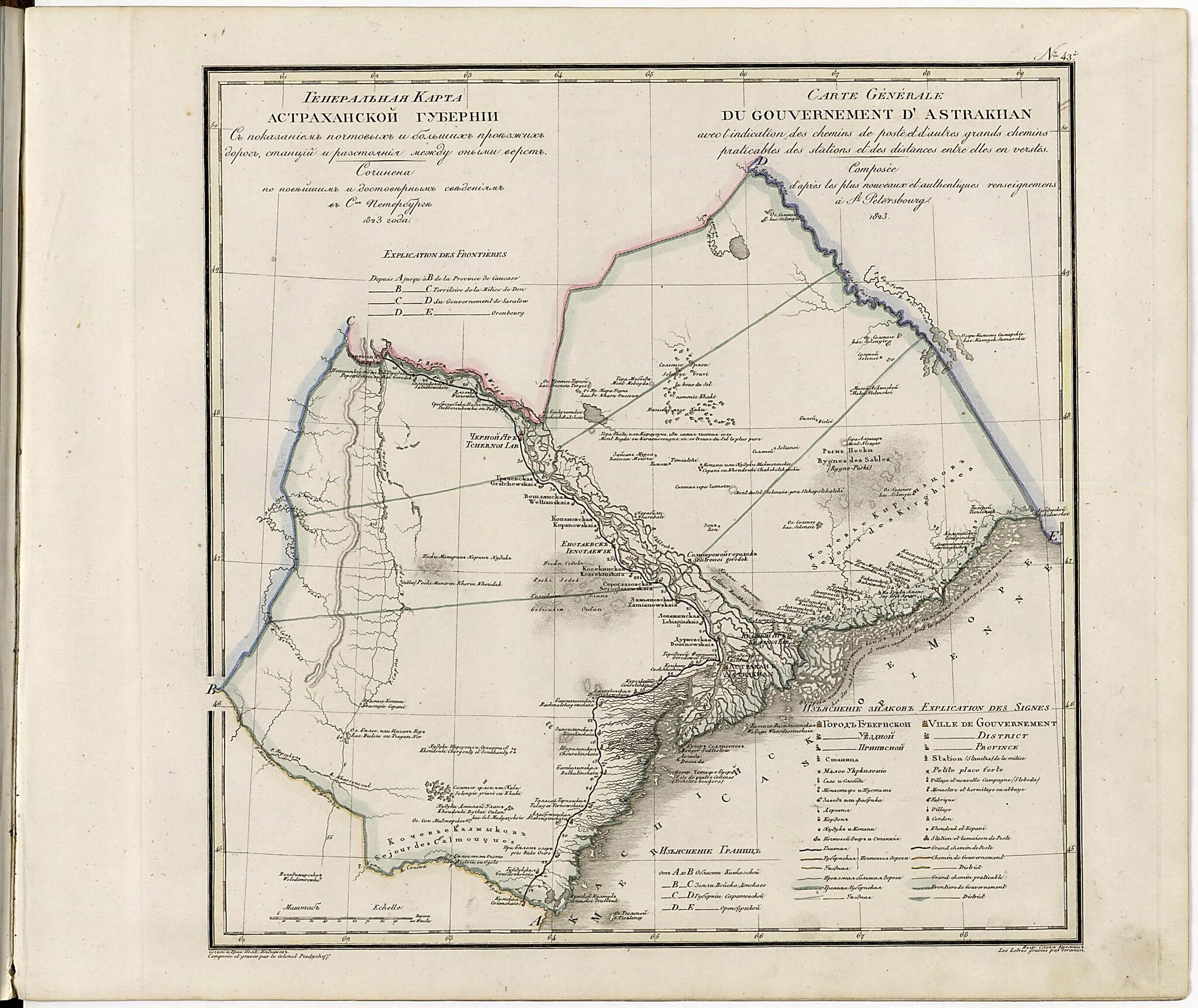1
/
of
1
Generalʹnai︠a︡ Karta Astrakhanskoĭ Gubernii Sʺ Pokazaniemʺ Pochtovykhʺ I Bolʹshikhʺ Proi︠e︡zzhikhʺ Dorogʺ, Stant︠s︡iĭ I Razstoi︠a︡nii︠a︡ Mezhdu Onymi Verstʺ. (Генеральная Карта Астраханской Г...
- Regular price
-
$33.95 - Regular price
-
$52.95 - Sale price
-
$33.95
Couldn't load pickup availability
90-Day Satisfaction Guarantee & Free Returns
About This Map
Discover the timeless beauty of our fine art quality printed reproduction of this antique map. Perfect for history enthusiasts, collectors, and interior decorators.
Restored with meticulous attention to detail by our team with over a decade of experience, this stunning reproduction captures the intricate artistry and historical significance of the original map.
Whether you're a collector or seeking a unique decor piece, this archival-quality map reproduction is a timeless addition to any space. Order now to bring history to life!
Old map of Astrakhan Oblast, Russian Federation.names are in Russian and French. Astrakhan was founded in about the 13th century, in the upper delta of the Volga River. For centuries, the city was at the crossroads of the civilizations of Europe, Asia, India, Persia, Georgia, and Armenia. Astrakhan was also located near Sarai, the famous capital of the western Mongol kingdom, the Golden Horde. Sarai (near Selitrenoi gorodok on this map) was established in the 1240s by the Mongol ruler, Badu Khan. Russian princes throughout the medieval period had to travel to Sarai and pay tribute to the khan. They also had to receive the khan's yarlyk (patent of authority), and sometimes traveled as far as Karakorum (present-day Mongolia) as a political necessity to visit the Great Khan. The Astrakhan region was besieged over the centuries by Timur, the sultans of Ottoman Turkey, and ultimately the tsars of Russia. In 1556, Ivan the Terrible conquered the Khanate of Astrakhan, a remnant state of the Mongols, and absorbed the region into the realms of Muscovy. This constituted the symbolic final ascendance of Russia after centuries of struggle with the Mongol yoke. Astrakhan continued to witness social and political upheavals, including the Cossack rebellions of Stepan Timofeevich Razin (known as Stenka Razin) in the 17th century and Kondratii Bulavin in the 18th century. The city rose to economic prominence under Peter the Great and Catherine the Great in the 18th century, as the Russian gateway to the Caspian Sea. World Digital Library.
Created by Ieremin, Vasiliĭ Petrovich Pi︠a︡dyshev, Russia. General Staff. Military Topographical Depot in 1823.
- No. 43 Iz izdanii︠a︡: Geograficheskiĭ atlas Rossiĭskoĭ imperii, T︠S︡arstva Polʹskago i Velikago Kni︠a︡zhestva Finli︠a︡ndskogo. Raspolozhennyĭ po gubernii︠a︡m na dvukh i︠a︡zykakh s oznacheniem v onykh gorodov, mestechek, sel, derevenʹ i vsekh primechatelʹneĭshikh mest; pochtovykh i bolʹshikh proezzhikh dorog, stant︠s︡iĭ i razstoi︠a︡niĭ mezhdu onymi, i prochimi selenii︠a︡mi v verstakh i mili︠a︡kh. Na 70 listakh s Generalʹnoi︠u︡ kartoi︠u︡ i Tablit︠s︡ei︠u︡ razstoi︠a︡nii︠a︡ verst po pochtovym dorogam mezhdu znatneĭshimi gorodami. Sochinen po noveĭshim i dostovernym svedenii︠a︡m, v polʹzu obuchai︠u︡shchikhsi︠a︡ Rossiĭskoĭ Geografii i dli︠a︡ sostavlenii︠a︡ dorozhnikov puteshestvennikam, Sluzhashchim v Voenno-topograficheskom Depo, Svity Ego Imperatorskago Velichestva po kvartirmeĭsterskoĭ chasti Podpolkovnikom Pi︠a︡dyshevym, 1821 goda. [SPb., 1820-1827]. Gravi︠u︡ra, raskrashena. Kartograficheskai︠a︡ setka cherez 1°; schet dolgot ot Ferro. Parallelʹno na frant︠s︡uzskom i︠a︡zyke.
- Uslovnye znaki: naselennye punkty (6 grupp), malye ukreplenii︠a︡, monastyri i pustyni, zavody i fabriki, kordony, khuduki i kopani, pochtovye dvory i stant︠s︡ii, dorogi (4 vida), granit︠s︡y (gubernskai︠a︡, uezdnai︠a︡). Pokazany: kochevʹi︠a︡ nadpisi︠a︡mi; solenye i presnye ozera, mesta dobychi soli, peschannye i bolotnye ostrova v delʹte Volgi, bolota, peski s nazvanii︠a︡mi, relʹef shtrikhami s nazvanii︠a︡mi nekotorykh gor. Ukazatelʹ: Izʺi︠a︡snenie granit︠s︡ (A-E).
- Original map at: National Library of Russia
- From the atlas "Географической атласъ Россiйской Имперiи, Царства Польскаго и Великаго княжества Финляндскаго."
- No. 43 Из издания: Географический атлас Российской империи, Царства Польскаго и Великаго Княжества Финляндского. Расположенный по губерниям на двух языках с означением в оных городов, местечек, сел, деревень и всех примечательнейших мест; почтовых и больших проезжих дорог, станций и разстояний между оными, и прочими селениями в верстах и милях. На 70 листах с Генеральною картою и Таблицею разстояния верст по почтовым дорогам между знатнейшими городами. Сочинен по новейшим и достоверным сведениям, в пользу обучающихся Российской Географии и для составления дорожников путешественникам, Служащим в Военно-топографическом Депо, Свиты Его Императорскаго Величества по квартирмейстерской части Подполковником Пядышевым, 1821 года. [СПб., 1820-1827]. Гравюра, раскрашена. Картографическая сетка через 1°; счет долгот от Ферро. Параллельно на французском языке.
- Условные знаки: населенные пункты (6 групп), малые укрепления, монастыри и пустыни, заводы и фабрики, кордоны, худуки и копани, почтовые дворы и станции, дороги (4 вида), границы (губернская, уездная). Показаны: кочевья надписями; соленые и пресные озера, места добычи соли, песчанные и болотные острова в дельте Волги, болота, пески с названиями, рельеф штрихами с названиями некоторых гор. Указатель: Изъяснение границ (А-Е).
Map Subjects
Astrakhan Oblast
Atlases
Russian Federation
Siberia
Ieremin
Vasiliĭ Petrovich Pi︠a︡dyshev
Russia. General Staff. Military Topographical Depot
1823
Map Tags
1823
Astrakhan Oblast
Atlases
Ieremin
Map
Maps
Russia. General Staff. Military Topographical Depot
Russian Federation
Siberia
Vasiliĭ Petrovich Pi︠a︡dyshev
Secure Checkout
Lifetime Warranty
Money-Back Guarantee

Map Sizing Information
- For the best legibility, order your map in the original size or larger. Most maps have intricate detail and small text that is best appreciated when the print size hasn't been reduced.
- Sizes labeled "Fits a Standard Frame" will drop right into any frame that you purchase in that size. The sizes that we offer are commonly available online and at most retail stores.
- Our standard sizes are recommendations based on the aspect ratio of the original map, but still may require some added "white space" in one dimension to fit.
- Non-standard sizes will require custom framing, and we suggest taking your print to the frame shop of your choice after you receive it for the best results.
- Custom sizes are available, simply contact us for a quote.
Below is an approximation of the scale of a few standard sizes, and how they might appear in your space.





